It is complicated and costly to keep astronauts breathing on the International Space Station (ISS) and other space vehicles.
The new proposed method using magnets could give astronauts the ability to go on longer space missions.
The new research was published in npj Microgravity by researchers from the University of Warwick, University of Colorado Bouldera and Freie Universität Berlin.
Oxygen on the ISS is manufactured through water electrolysis, a process where electricity from solar panels that splits water into hydrogen gas and oxygen gas.
However, better technology will be needed if humans want space travel to be more accessible in the future.
Lead author Álvaro Romero-Calvo from the University of Colorado Boulder said this would be impractical for a mission to Mars for example.
“On the International Space Station, oxygen is generated using an electrolytic cell that splits water into hydrogen and oxygen, but then you have to get those gasses out of the system,” Romero-Calvo said.

The researchers are suggesting magnets be used to perform the same role but with lower energy requirements and hopefully better reliability.
They used the Bremen Drop Tower which simulates microgravity, and demonstrated a procedure to detach gas bubbles from electrode surfaces in microgravity environments.
Their study for the first time showed how gas bubbles can be attracted to and repelled from a simple neodymium magnet by immersing it in different aqueous solutions.
Dr Katharina Brinkert from the University of Warwick and one of the authors of the study said “these effects have tremendous consequences for the further development of phase separation systems, such as for long-term space missions”.
The next phase is to test this in space as the team of scientists are now looking to do, and if all goes well it could make life in space easier.






